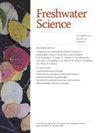Assessing seasonal and biological indices of juvenile Chinook Salmon for freshwater decision triggers that increase ocean survival
IF 1.6
4区 环境科学与生态学
Q3 ECOLOGY
引用次数: 1
Abstract
Decision triggers, used in adaptive management frameworks to decide when a specific management action will be implemented, are often informed by monitoring data. The identification and application of decision triggers is highly relevant to endangered fishes migrating through regulated rivers, as examined in the current study. The main goal was to determine whether seasonal patterns of behavioral, physical, and physiological indices of juveniles were related to subsequent smolt-to-adult return (SAR) survival and, if so, to determine whether these indices could be used to guide decisions related to the mitigation strategy of the juvenile fish transportation program in the Federal Columbia River Power System (Pacific Northwest, USA). Hatchery yearling Chinook Salmon (Oncorhynchus tshawytscha Walbaum in Artedi, 1792) were collected over the migration season at 3 dams in the hydrosystem and measured for fork length, wet mass, Fulton’s K (or condition factor), Na+/K+-ATPase (NKA) activity (or smoltification index), and % dry mass (or index of energetic reserves and smoltification). We estimated SAR survival from passive integrated transponder-tagged fish representative of our field samples and assessed its relationship to our fish indices, as well as indices of transported vs run-of-river passage and distance of sampling site to ocean. SAR survival was associated to interaction effects between juvenile fish transportation and % dry mass or NKA activity. Transported hatchery Chinook Salmon with dry mass <23% of whole fish wet mass and NKA activity >7 µmol ADP mg protein−1 h−1 showed greater SAR survival than their run-of-river counterparts. Fish with the highest predicted SAR survival had been transported and had fish indices consistent with smolts that were more developed (i.e., lower % dry mass and higher NKA activity). Furthermore, our results on % dry mass provided support for the hypothesis that greater lipid content increases fish buoyancy leading to greater susceptibility to predation. The buoyancy effect is expected to be greatest in hatchery fish. Overall, this study shows that decision triggers based on biological indices of migrating fish are potentially useful tools for in-season management.评估幼年奇努克三文鱼的季节和生物指数,以确定增加海洋生存的淡水决策触发因素
自适应管理框架中用于决定何时实施具体管理行动的决策触发器通常由监测数据提供信息。如本研究所述,决策触发器的识别和应用与通过受管制河流迁徙的濒危鱼类高度相关。主要目标是确定青少年的行为、身体和生理指标的季节性模式是否与随后的闷烧-成年回归(SAR)存活率有关,如果是,以确定这些指数是否可用于指导与联邦哥伦比亚河电力系统(美国西北太平洋地区)幼鱼运输计划的缓解策略相关的决策。在迁徙季节,在水生系统的3个水坝采集了孵化一年的奇努克鲑鱼(Oncorhynchus tshawytscha-Wallbaum in Artedi,1792),并测量了叉长、湿质量、富尔顿K(或条件因子)、Na+/K+-ATP酶(NKA)活性(或闷烧指数)和%干质量(或能量储备和闷烧的指数)。我们估计了无源集成转发器标记的鱼类(代表我们的现场样本)的SAR生存率,并评估了其与我们的鱼类指数的关系,以及运输与河道流量的指数和采样点与海洋的距离。SAR存活率与幼鱼运输和%干物质或NKA活性之间的相互作用有关。干质量为7µmol ADP mg蛋白−1 h−1的运输孵化场奇努克三文鱼的SAR存活率高于河流中的同类。预测SAR存活率最高的鱼类已被运输,其鱼类指数与更发达的smots一致(即较低的干物质百分比和较高的NKA活性)。此外,我们关于%干质量的结果支持了这样一种假设,即更高的脂质含量会增加鱼类的浮力,从而更容易被捕食。预计孵化场鱼类的浮力效应最大。总的来说,这项研究表明,基于洄游鱼类生物学指数的决策触发器是季节管理的潜在有用工具。
本文章由计算机程序翻译,如有差异,请以英文原文为准。
求助全文
约1分钟内获得全文
求助全文
来源期刊

Freshwater Science
ECOLOGY-MARINE & FRESHWATER BIOLOGY
CiteScore
4.10
自引率
0.00%
发文量
49
审稿时长
6-12 weeks
期刊介绍:
Freshwater Science (FWS) publishes articles that advance understanding and environmental stewardship of all types of inland aquatic ecosystems (lakes, rivers, streams, reservoirs, subterranean, and estuaries) and ecosystems at the interface between aquatic and terrestrial habitats (wetlands, riparian areas, and floodplains). The journal regularly features papers on a wide range of topics, including physical, chemical, and biological properties of lentic and lotic habitats; ecosystem processes; structure and dynamics of populations, communities, and ecosystems; ecology, systematics, and genetics of freshwater organisms, from bacteria to vertebrates; linkages between freshwater and other ecosystems and between freshwater ecology and other aquatic sciences; bioassessment, conservation, and restoration; environmental management; and new or novel methods for basic or applied research.
 求助内容:
求助内容: 应助结果提醒方式:
应助结果提醒方式:


